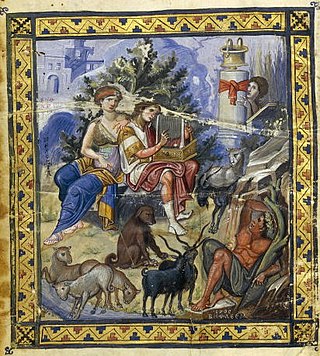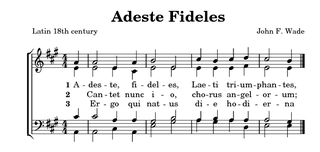Related Research Articles

The Book of Psalms, also known as the Psalter, is the first book of the third section of the Tanakh called Ketuvim ('Writings'), and a book of the Old Testament.

In music, harmony is the concept of combining different sounds together in order to create new, distinct musical ideas. Theories of harmony seek to describe or explain the effects created by distinct pitches or tones coinciding with one another; harmonic objects such as chords, textures and tonalities are identified, defined, and categorized in the development of these theories. Harmony is broadly understood to involve both a "vertical" dimension (frequency-space) and a "horizontal" dimension (time-space), and often overlaps with related musical concepts such as melody, timbre, and form.
Overture is a music instrumental introduction to a ballet, opera, or oratorio in the 17th century. During the early Romantic era, composers such as Beethoven and Mendelssohn composed overtures which were independent, self-existing, instrumental, programmatic works that foreshadowed genres such as the symphonic poem. These were "at first undoubtedly intended to be played at the head of a programme".

Luigi Lablache was an Italian opera singer of French and Irish ancestry. He was most noted for his comic performances, possessing a powerful and agile bass voice, a wide range, and adroit acting skills: Leporello in Don Giovanni was one of his signature roles.
The Aeolian mode is a musical mode or, in modern usage, a diatonic scale also called the natural minor scale. On the piano, using only the white keys, it is the scale that starts with A and continues to the next A only striking white keys. Its ascending interval form consists of a key note, whole step, half step, whole step, whole step, half step, whole step, whole step. That means that, in A aeolian, a scale would be played beginning in A, move up a whole step to B, move up a half step to C, then up a whole step to D, a whole step to E, a half step to F, a whole step to G, and a final whole step to a high A.
The Phrygian mode can refer to three different musical modes: the ancient Greek tonos or harmonia, sometimes called Phrygian, formed on a particular set of octave species or scales; the medieval Phrygian mode, and the modern conception of the Phrygian mode as a diatonic scale, based on the latter.

La gazza ladra is a melodramma or opera semiseria in two acts by Gioachino Rossini, with a libretto by Giovanni Gherardini based on La pie voleuse by Théodore Baudouin d'Aubigny and Louis-Charles Caigniez. The Thieving Magpie is best known for the overture, which is musically notable for its use of snare drums. This memorable section in Rossini's overture evokes the image of the opera's main subject: a devilishly clever, thieving magpie.

A metrical psalter is a kind of Bible translation: a book containing a verse translation of all or part of the Book of Psalms in vernacular poetry, meant to be sung as hymns in a church. Some metrical psalters include melodies or harmonisations. The composition of metrical psalters was a large enterprise of the Protestant Reformation, especially in its Calvinist manifestation.

The Hypodorian mode, a musical term literally meaning 'below Dorian', derives its name from a tonos or octave species of ancient Greece which, in its diatonic genus, is built from a tetrachord consisting of a semitone followed by two whole tones. The rising scale for the octave is a single tone followed by two conjoint tetrachords of this type. This is roughly the same as playing all the white notes of a piano from A to A: A | B C D E | (E) F G A. Although this scale in medieval theory was employed in Dorian and Hypodorian, from the mid-sixteenth century and in modern music theory they came to be known as the Aeolian and Hypoaeolian modes.

The Genevan Psalter, also known as the Huguenot Psalter, is a 1539 metrical psalter in French created under the supervision of John Calvin for liturgical use by the Reformed churches of the city of Geneva in the sixteenth century.

Tonic sol-fa (or tonic sol-fah) is a pedagogical technique for teaching sight-singing, invented by Sarah Anna Glover (1786–1867) of Norwich, England and popularised by John Curwen, who adapted it from a number of earlier musical systems. It uses a system of musical notation based on movable do solfège, whereby every note is given a name according to its relationship with other notes in the key: the usual staff notation is replaced with anglicized solfège syllables (e.g. the syllable la for the submediant) or their abbreviations (l for la). "Do" is chosen to be the tonic of whatever key is being used (thus the terminology moveable Do in contrast to the fixed Do system used by John Pyke Hullah). The original solfège sequence started with "Ut", the first syllable of the hymn Ut queant laxis, which later became "Do".

A hymn tune is the melody of a musical composition to which a hymn text is sung. Musically speaking, a hymn is generally understood to have four-part harmony, a fast harmonic rhythm, with or without refrain or chorus.

Torvaldo e Dorliska is an operatic dramma semiserio in two acts by Gioachino Rossini to an Italian libretto by Cesare Sterbini, based on the novel/memoir Les Amours du chevalier de Faublas (1787–1790) by the revolutionary Jean-Baptiste Louvet de Couvrai, whose work was the source of the Lodoïska libretto set by Luigi Cherubini (1791), and Lodoiska set by Stephen Storace (1794), and Simon Mayr (1796).
Will Crutchfield is an American conductor, musicologist, and vocal coach. He is the founding Artistic and General Director of Teatro Nuovo, a company that presented its inaugural season in the summer of 2018 at Lincoln Center's Frederick P. Rose Hall as the successor to the twenty years of opera at the Caramoor International Music Festival led by Crutchfield. He also has been a frequent guest conductor at the Polish National Opera and has led opera performances at the Canadian Opera Company, Washington National Opera, and Minnesota Opera. From 1999 through 2005, he served as Music Director of the Opera de Colombia in Bogotá. He was recently named one of Musical America's 2017 "Movers and Shapers," the publication's list of the top 30 industry professionals of the year.
The musical system of ancient Greece evolved over a period of more than 500 years from simple scales of tetrachords, or divisions of the perfect fourth, into several complex systems encompassing tetrachords and octaves, as well as octave scales divided into seven to thirteen intervals.

The Conservatorio Statale di Musica "Gioachino Rossini" is a music conservatory in Pesaro, Italy. Founded in 1869 with a legacy from the composer Gioachino Rossini, the conservatory officially opened in 1882 with 67 students and was then known as the Liceo musicale Rossini. By 2010 it had an enrollment of approximately 850 students studying for higher diplomas in singing, instrumental performance, composition, musicology, choral conducting, jazz or electronic music. The conservatory also trains music teachers for secondary schools and holds regular master classes. Its seat is the 18th century Palazzo Olivieri–Machirelli on the Piazza Oliveri in Pesaro. Amongst its past Directors are the composers Carlo Pedrotti, Pietro Mascagni, Riccardo Zandonai and Franco Alfano. Mascagni's opera Zanetto had its world premiere at the conservatory in 1896.
A tetratonic scale is a musical scale or mode with four notes per octave. This is in contrast to a heptatonic (seven-note) scale such as the major scale and minor scale, or a dodecatonic scale, both common in modern Western music. Tetratonic scales are not common in modern art music, and are generally associated with prehistoric music.

Giuseppe de Begnis was an Italian operatic bass singer. Born in Lugo di Romagna, he started his musical education when he was 7 years old, under Padre Bongiovanni, and sang soprano in the church. At age 15 he had serious problems with his voice and began studying acting under Mandini, a famous actor of the time. His father did not want Giuseppe to become a comedian and in due course the young man became a pupil of the composer Giovanni Morandi, the husband of the singer Rosa Morandi.

The Rossini Bicentennial Birthday Gala is a live album of operatic and sacred music by Gioachino Rossini, performed by Rockwell Blake, Craig Estep, Maria Fortuna, Thomas Hampson, George Hogan, Marilyn Horne, Kathleen Kuhlmann, Mimi Lerner, Chris Merritt, Jan Opalach, Samuel Ramey, Henry Runey, Frederica von Stade, Deborah Voigt, the Concert Chorale of New York and the Orchestra of St. Luke's under the direction of Sir Roger Norrington. It was released in 1993 as a 119-minute video album and in 1994 as a 78-minute CD.
Savino Monelli was an Italian tenor prominent in the opera houses of Italy from 1806 until 1830. Amongst the numerous roles he created in world premieres were Giannetto in Rossini's La gazza ladra, Enrico in Donizetti's L'ajo nell'imbarazzo and Nadir in Pacini's La schiava in Bagdad. He was born in Fermo where he initially studied music. After leaving the stage, he retired to Fermo and died there five years later at the age of 52.
References
- ↑ Charles William Pearce (1920). "The Futility of the Anglican Chant". The Musical Quarterly. 6 (1): 118–26. doi:10.1093/mq/vi.1.118 . Retrieved 21 June 2012. Citation on p. 119–20.
- ↑ John Henry Blunt (ed.), The Annotated Book of Common Prayer. London and New York: Longmans, Green, and Co. 1895. p. 56 . Retrieved 21 June 2012. Digitized reprint by Forgotten Books. ISBN 978-1-4400-9198-8.
- ↑ Mervyn McLean (1969) "An Analysis of 651 Maori Scales", Yearbook of the International Folk Music Council 1:123–64. Citation on p. 161
- ↑ Reul, Barbara M.; Byrne Bodley, Lorraine, eds. (2008). The Unknown Schubert. Aldershot, Hants; Burlington, VT: Ashgate Publishing, Ltd. p. 22. ISBN 978-0-7546-6192-4 . Retrieved 21 June 2012.
- ↑ Philip Gossett (2001) "Rossini, Gioachino, §3: From Tancredi to La gazza ladra", The New Grove Dictionary of Music and Musicians, second edition, edited by Stanley Sadie and John Tyrrell (London: Macmillan Publishers).
- ↑ Philipp Spitta, Joachim Veit, Thomas Bauman, Patricia Lewy Gidwitz, John Warrack, and Michael C. Tusa (2001), "Weber: (9) Carl Maria (Friedrich Ernst) von Weber", The New Grove Dictionary of Music and Musicians, second edition, edited by Stanley Sadie and John Tyrrell (London: Macmillan Publishers).
- ↑ Anderson, Keith (February 2007). "Argene's One-Note Aria". Gioachino Rossini (1792-1868): Ciro in Babilonia (booklet). Naxos. 8.660203-04. Retrieved 29 December 2024.
- This article quotes content from The Musical Quarterly , Volume 6 (1920) edited Oscar George Theodore Sonneck, a work in the public domain.